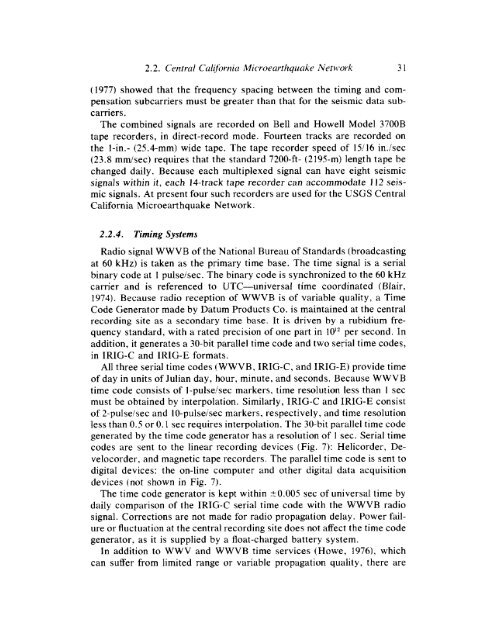principles and applications of microearthquake networks
principles and applications of microearthquake networks
principles and applications of microearthquake networks
Create successful ePaper yourself
Turn your PDF publications into a flip-book with our unique Google optimized e-Paper software.
2.2. Cenrral Cdijbmicr Micwearthyuuke Netu-ork 31<br />
(1977) showed that the frequency spacing between the timing <strong>and</strong> compensation<br />
subcarriers must be greater than that for the seismic data subcarriers.<br />
The combined signals are recorded on Bell <strong>and</strong> Howell Model 3700B<br />
tape recorders, in direct-record mode. Fourteen tracks are recorded on<br />
the ]-in.- (25.4-mm) wide tape. The tape recorder speed <strong>of</strong> 15/16 in./sec<br />
(23.8 mdsec) requires that the st<strong>and</strong>ard 7200-ft- (2195-m) length tape be<br />
changed daily. Because each multiplexed signal can have eight seismic<br />
signals within it, each 14-track tape recorder can accommodate I12 seismic<br />
signals. At present four such recorders are used for the USGS Central<br />
California Microearthquake Network.<br />
2.2.4. Timing Systems<br />
Radio signal WWVB <strong>of</strong> the National Bureau <strong>of</strong> St<strong>and</strong>ards (broadcasting<br />
at 60 kHz) is taken as the primary time base. The time signal is a serial<br />
binary code at 1 pulseisec. The binary code is synchronized to the 60 kHz<br />
carrier <strong>and</strong> is referenced to UTC-universal time coordinated (Blair,<br />
1974). Because radio reception <strong>of</strong> WWVB is <strong>of</strong> variable quality, a Time<br />
Code Generator made by Datum Products Co. is maintained at the central<br />
recording site as a secondary time base. It is driven by a rubidium frequency<br />
st<strong>and</strong>ard, with a rated precision <strong>of</strong> one part in 10" per second. In<br />
addition, it generates a 30-bit parallel time code <strong>and</strong> two serial time codes,<br />
in IRIG-C <strong>and</strong> IRIG-E formats.<br />
All three serial time codes (WWVB, IRIG-C. <strong>and</strong> IRIG-E) provide time<br />
<strong>of</strong> day in units <strong>of</strong> Julian day, hour, minute, <strong>and</strong> seconds. Because WWVB<br />
time code consists <strong>of</strong> I-pulse!sec markers, time resolution less than 1 sec<br />
must be obtained by interpolation. Similarly, IRIG-C <strong>and</strong> IRIG-E consist<br />
<strong>of</strong> 2-pulse/sec <strong>and</strong> 10-pulseisec markers, respectively, <strong>and</strong> time resolution<br />
less than 0.5 or 0.1 sec requires interpolation. The 30-bit parallel time code<br />
generated by the time code generator has a resolution <strong>of</strong> 1 sec. Serial time<br />
codes are sent to the linear recording devices (Fig. 7): Helicorder, Develocorder,<br />
<strong>and</strong> magnetic tape recorders. The parallel time code is sent to<br />
digital devices: the on-line computer <strong>and</strong> other digital data acquisition<br />
devices (not shown in Fig. 7).<br />
The time code generator is kept within 20.005 sec <strong>of</strong> universal time by<br />
daily comparison <strong>of</strong> the IRIG-C serial time code with the WWVB radio<br />
signal. Corrections are not made for radio propagation delay. Power failure<br />
or fluctuation at the central recording site does not affect the time code<br />
generator, as it is supplied by a float-charged battery system.<br />
In addition to WWV <strong>and</strong> WWVB time services (Howe, 19761, which<br />
can suffer from limited range or variable propagation quality. there are






